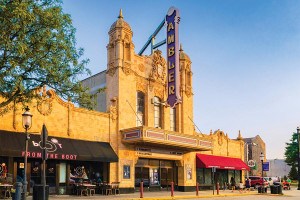Philadelphia’s Most Endangered Properties 2013
The big news that was embargoed until this morning yet released yesterday anyway is the Preservation Alliance for Greater Philadelphia’s 11th Annual Endangered Properties List. It should come as no surprise that the list includes all of the city’s closed schools. But let’s start with Market East.
 Robinson Store
Robinson Store
Victor Gruen and Elsie Krummeck, 1946 1020 Market Street, Philadelphia
As interest and activity increases around development of East Market Street, older buildings — some of them historic — may be threatened. That’s certainly the case with the Robinson Store, built by Victor Gruen and Elsie Krummeck, who partnered to design 11 stores for the Grayson-Robinson chain (which sold ladies’ underwear at low prices. Oh, Robinson, where are you now?). Gruen is an especially important figure in commercial architecture, whether you love him or hate him, as he’s known as the inventor of the shopping mall.
The Robinson Store in Center City is easy to pass by without a glance, but as the Alliance points out, it is “the last surviving example of a building campaign that epitomized the use of architecture as advertisement.” It’s a Don Draper dream.
And that’s not all that’s threatened by East Center City development. The former Coward Shoes at 1118 Chestnut is scheduled to be demolished in early 2014 — and that circa-1949 building was designed by Louis Kahn and Oskar Stonorov. Unfortunately, it’s pretty much impossible to tell that either of the buildings were ever especially impressive, so the facades would need to be restored.
As that’s not going to happen with 1118, the Alliance is calling for the restoration of the Robinson façade, which actually would benefit the developer who did it because the store is within a district that incentivizes facade improvements. “It would be a major preservation victory and could anchor any number of redevelopment plans for the rest of the block.”
Now for the other sites…

Irvin R. Glazer Theater Collection, The Athenaeum of Philadelphia
Boyd Theatre (pictured above)
Hoffman-Henon Company, 1928, 1910 Chestnut Street, Philadelphia
The internationally famous motion picture palace is an Art Deco wonder inside, with its lobbies and auditorium remarkably untouched. Live Nation applied to demolish the interior a few months ago, which would certainly be the same agenda for iPic, the theater chain that wants to turn the treasure into a multiplex.
The Legendary Blue Horizon
Carl Berger, 1917 (auditorium); 1865 (front facades) 1314-16 N. Broad Street, Philadelphia
A celebrated boxing venue for about 50 years, the Legendary Blue Horizon “was named the best boxing venue in the world by Ring Magazine in 1999.” After a restoration in 2004, the Preservation Alliance gave it the Grand Jury Achievement Award. But current developers Mosaic Development and Orens Brothers plan to demolish “the entire rear of the structure.”
Nineteenth Street Baptist Church
Furness & Hewitt, 1874 1249-53 S. 19th Street, Philadelphia
“The striking green serpentine stone building is one of the pair’s most colorful and original church designs, reflecting the fashionable tastes of the High Victorian Gothic period.” The problem? The building is falling apart and has been condemned. Demolition is being held at bay — but just barely.
Engine 46 Firehouse
John T. Windrim (attributed), 1894 1401 S. Water Street, Philadelphia
This somewhat loony-looking Pennsport building with a Flemish Revival façade represents a time when optimism — even about the schools — was high. Its “flamboyant” appearance was a celebration of the city, of “the rapid expansion of its schools, parks, and police and fire departments.” Now, Cedar Realty has a permit to demolish — but may hold off if a suitable tenant can be found.
Shawmont Station
William Strickland (attributed), 1834 7700 Nixon Street, Philadelphia
This is the oldest surviving passenger railroad station in the United States. Does anything more need to be said to justify the need for its preservation? There used to be a caretaker for the building, but now it stands empty. What will happen to it if no one protects it? “The station’s modest physical stature should not overshadow its profound significance in railroad history.”
Haddington Historic District
Bounded by 60th, Market, 61st & Chestnut Streets, Philadelphia
Who knew this stretch of West Philly was on the National Register of Historic Places? It is “recognized as the best-preserved of the early twentieth century developments that followed the construction of the Market Street Elevated Line in West Philadelphia.” Unfortunately, increased commerce, blight and calls for demolition are posing a threat.


